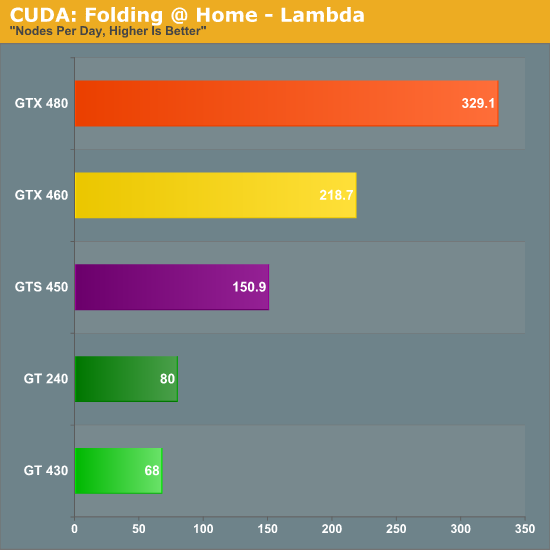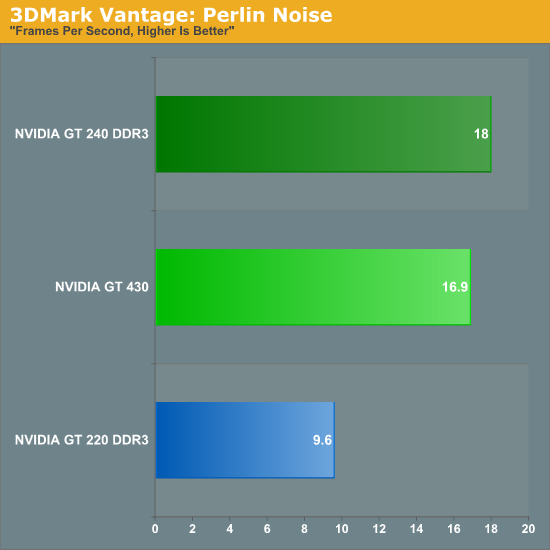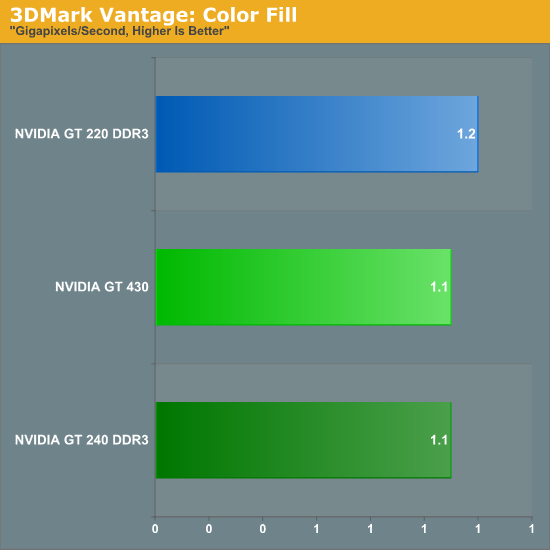NVIDIA's GeForce GT 430: The Next HTPC King?
by Ryan Smith & Ganesh T S on October 11, 2010 9:00 AM ESTCompute Performance & Synthetics
While the GT 430 isn’t meant to be a computing monster and you won’t see NVIDIA presenting it as such, it’s still a member of the Fermi family and possesses the family’s compute capabilities. This includes the Fermi cache structure, along with the 48 CUDA core SM that was introduced with GF104/GTX 460. This also means that it has a greater variation of performance than the past-generation NVIDIA cards; the need to extract ILP means the card performs between a 64 CUDA core card and a 96 CUDA core card depending on the application.
Meanwhile being based on the GF104 SM, the GT 430 is FP64 capable at 1/12th FP32 speeds (~20 GFLOPS FP64), a first for a card of this class.
For our look at compute performance we’ll turn to our trusty benchmark copy of Folding @ Home. We’ve also included the GT 240, a last-generation 96 CUDA core card just like the GT 430. This affords us an interesting opportunity to see the performance of Fermi compared to GT200 with the same number of CUDA cores in play, although GT 430 has a clockspeed advantage here that gives it a higher level of performance in theory.

The results are interesting, but also a bit distressing. GT 430’s performance as compared to the GTS 450’s performance is quite a bit lower, but this is expected. GT 240 however manages to pull ahead by nearly 17%, which is quite likely a manifestation of Fermi’s more variable performance. This makes the GT 220 comparison all the more appropriate, as if Fermi’s CUDA cores are weaker on average then GT 430 can’t hope to keep pace with GT 240.
To take a second look at CUDA core performance, we’ve also busted 3DMark Vantage out of the vault. As we’ve mentioned before we’re not huge fans of synthetic tests like 3DMark since they encourage non-useful driver optimizations for the benchmark instead of real games, but the purely synthetic tests do serve a useful purpose when trying to get to the bottom of certain performance situations.
We’ll start with the Perlin Noise test, which is supposed to be computationally bound, similar to Folding @ Home.

Once more we see the GT 430 come in behind the GT 240, even though the GT 430 has the theoretical advantage due to clockspeed. The loss isn’t nearly as great as it was under Folding @ Home, but this lends more credit to the theory that Fermi shaders are less efficient than GT21x CUDA cores. As a card for development GT 430 still has a number of advantages such as the aforementioned FP64 support and C++ support in CUDA, but if we were trying to use it as a workhorse card it looks like it wouldn’t be able to keep up with GT 240. Based on our gaming results earlier, this would seem to carry over to shader-bound games, too.
Moving on, we also used this opportunity to look at 3DMark Vantage’s color fill test, which is a ROP-bound test. With only 4 ROPs on the GT 430, this is the perfect synthetic test for seeing if having fewer ROPs really is an issue when we’re comparing GT 430 to older cards.

And the final verdict? A not very useful yes and no. GT 220 and GT 240 both have 8 ROPs, with GT 220 having the clockspeed advantage. This is why GT 220 ends up coming out ahead of GT 240 here by less than 100 MPixels/sec. But on the other hand, GT 430 has a clockspeed advantage of its own while possessing half the ROPs. The end result is that GT 430 is effectively tied with these previous-generation cards, which is actually quite a remarkable feat for having half the ROPs.
NVIDIA worked on making the Fermi ROPs more efficient and it has paid off by letting them use 4 ROPs to do what took 8 in the last generation. With this data in hand, NVIDIA’s position that 4 ROPs is enough is much more defensible, as they’re at least delivering last-generation ROP performance on a die not much larger than GT216 (GT 220). This doesn’t provide enough additional data to clarify whether the ROPs alone are the biggest culprit in the GT 430’s poor gaming performance, but it does mean that we can’t rule out less efficient shaders either.
Do note however that while Fermi ROPs are more efficient than GT21x ROPs, it’s only a saving grace when doing comparisons to past-generation architectures. GT 430 still only has ¼ the ROP power as GTS 450, which definitely hurts the card compared to its more expensive sibling.










120 Comments
View All Comments
Spazweasel - Monday, October 11, 2010 - link
I think something very important is being missed in reviews of cards evaluated for HTPC use: the effects of the form factor of a case.Many HTPCs are in low-profile desktop-style chassis in an effort to visually integrate with the rest of home theater gear. Examples: Antec MicroFusion, nMediaPC HTPC 1080P, Lian Li PC36. These cases cannot accept standard-height cards, and must use low-profile-compatible (half height) cards. Additionally, the low profile of the cases severely inhibits airflow, which renders "open bench" and "inside a cavernous full tower case" thermal and acoustic testing largely irrelevant.
There are also HTPC cases which accept standard-height cards but are only barely tall enough to accommodate those cards, also impairing airflow, and are thus good test targets. Examples: nMediaPC HTPC 1000, Antec Fusion.
Therefore I suggest the following be added for consideration in any card which is ostensibly intended for an HTPC build:
1. Is the card available in low-profile designs?
2. For a given manufacturer's entry, is the low-profile bracket included?
3. Thermal testing and acoustic testing on low-profile cards performed in a low-profile case with all panels in place
4. Thermal testing and acoustic testing on standard-height cards performed in a case that is exactly as tall as a standard PC card, i.e. Antec Fusion, also with all panels in place.
5. Please report card-length. HTPC and other compact cases often have an issue with this.
Thanks very much!
ganeshts - Monday, October 11, 2010 - link
Thanks for the pointers. We will keep these in mind for future GPU reviews.1. Yes, the card is available in low profile designs, but it is dual slot because of the heat sink.
2. I only have a nV reference card, but Ryan has the Asus one. I will ask him about questions 2 - 5.
blastingcap - Monday, October 11, 2010 - link
"advertized"??AznBoi36 - Monday, October 11, 2010 - link
Come on AMD/Nvidia. Give us a cool running, low profile gaming card that is capable of playing games at 1080p and I'll buy it.Spazweasel - Monday, October 11, 2010 - link
Have you seen the PowerColor AX5750? It's a Radeon 5750-based card, 1gb DDR5, which is low profile. As far as I know, that's the most oomph you can get in a low profile card at present. 1080p gaming on a single 5750 would be marginal, near 30fps for moderate settings on most modern games, but if you can deal with that or don't mind pushing the sliders a bit to the left it may be doable. All depends upon your requirements. Sliders slammed to the right and 8x antialiasing? Not gonna happen :)If you need more, you can always try a Crossfire rig. In a low profile case that would be thermally brutal, however, and given that the PowerColor AX5750 uses a dual-fan cooling rig that does not exhaust out the back, two of them in a low-profile case might just be too much.
The good news is that the 5750 doesn't draw much power. Guru3D had a test that showed a 5750 Crossfire rig peaking at 401 watts, and that's with a much beefier CPU/motherboard setup (Core i7/965 OC to 3750mhz) than you would see in a typical HTPC rig. With something gentler like a standard-clocked Core i5 or Core i3, or a Propus 620e, you probably will never exceed 350 watts in a Crossfire setup, so you can stick to 450-500 watt PSUs in complete confidence for a pair of 5750. For a single 5750, a 350-400 watt unit (example: Antec's 380-watt PSUs that come with some of their cases) would be just fine.
fuzzymath10 - Monday, October 11, 2010 - link
I'm using the Powercolor 5750 Low Profile in an NSK1480 and that size of case is probably about as small as you'd want to go for gaming before stuff gets too hot and/or noisy. These cases often don't have the 6- and 8-pin power connectors you often need and dangling too many off molex adapters is a bit risky.However, it does run at good temps and quietly even overclocked from 700/1150 to 865/1265 and after slowing down the fan. It probably helps that I have two Noctuas, two Scythe S-flexes, and a very undervolted Q8200.
Spazweasel - Monday, October 11, 2010 - link
As far as case volume is concerned, I think the SFF form-factor companies like Shuttle are producing are actually smaller. But because those cases are taller and blockier, air has room to circulate over the top of cards; also, big noisy fans are more acceptable in an SFF gaming porta-rig than an HTPC in which silence is golden.Also, with LP cases, putting in a card effectively creates two new isolated compartments within a case (the card reaches from motherboard almost to to contact with the top cover, and from the back of the case almost to the front edge of the motherboard along the length of the card); air on one side of the card doesn't circulate with air on the other side of the card, and you're in trouble if either of those two new compartments doesn't have a robust source of cool air.
Per Hansson - Monday, October 11, 2010 - link
Hi, I guess this card would be the same as the announced nVidia Quadro 600?Guess maybe even my current uber crappy G84GL based Quadro 570 would be almost as fast...
That's one issue I see with GF108, sure here they are touting it as a HTPC thing, not for gamers
But it's ok to sell it as a Quadro and charging €200 for it instead?
Meh
http://www.anandtech.com/show/3961/nvidia-launches...
bearson - Monday, October 11, 2010 - link
Please beware of these cards from Asus. I have a GT220 which sounds like a helicopter and according to Asus the fan speed on these cards never speeds up or slows down. This seems to be confirmed in this article by looking at the idle vs load noise data.Thanks for a great site!
Best
softdrinkviking - Monday, October 11, 2010 - link
"At $80 the GT 430 goes up directly against the Radeon HD 5570 (DDR3 & GDDR5), sale-priced Radeon 5670s, the GT 430, and even the venerable 9800GT."Shouldn't this be "...priced Radeon 5670s, the GT 240, and even..."?